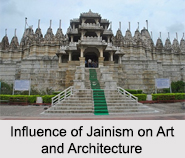 Influence of Jainism on Art and Architecture has enriched Indian art with special forms and symbols. It has evolved over the centuries, without losing its originality from the proto-historic period. The ancient Indian religions viz. Hinduism, Buddhism and Jainism, have made a great contribution to art, architecture and the performing arts. Jainism, though an ascetic religion, aesthetic ideas were reflected in literature and art.
Influence of Jainism on Art and Architecture has enriched Indian art with special forms and symbols. It has evolved over the centuries, without losing its originality from the proto-historic period. The ancient Indian religions viz. Hinduism, Buddhism and Jainism, have made a great contribution to art, architecture and the performing arts. Jainism, though an ascetic religion, aesthetic ideas were reflected in literature and art.
Specimens of Jain Architecture
The specimens of Jain Architecture are - Ayagapata, Stupa, Gumpha (Rock-cut Architecture) and Mandir Sthaptya (Temples).
Ayagapata: Ayagapata (Tablet of Homage) is an ornamental slab, constructed in memory of Tirthankaras or Acharyas (ascetics or monks), having the representation of a Jina or Tirthankara or some other object of worship. In an excavation at Kankali Tila at Mathura, some Ayagapatas of the 1st century A.D. were found. In one of them, the figure of Tirthankara was found surrounded by Astamangala symbols. Another Ayagapata had a stupa with the railing around and nine steps leading up to an ornamental gateway.
Stupa: The Stupa is a memorial mound, carved in memory of a Tirthankara or an Acharya. Remains of a Stupa were found from Kankali Tila, Mathura, with an inscription of 2nd century B. C. saying that the Stupa was built by Gods.
Gumpha: Jains excavated caves in different parts of the country as early as 2nd century B.C. Caves or Gumpha were excavated not only for worship, but also for providing shelter to Jain ascetics during their journey from one place to another. The earliest among these are Udayagiri and Khandagiri caves in Odisha. The antiquity of these caves is known from the inscription in Hathi-Gumpha (Elephant-cave), which says that King Kharvela of Kalinga constructed rock-dwellings and bestowed gifts to Jain devotees.
Badami, Aihole, Dharasinva, Ankai-Tankai, Mangi-Tungi are also some of the important Jain caves in Maharashtra. Bava-Pyara and Dhank in Junagadh are the only Jain caves found in Gujarat. Gwalior in Madhya Pradesh has a series of caves with colossal images of Tirthankaras and Yakshas. Sittannavasal and Kalugumalai are important Jain caves in South India. An excellent example of Jain cave architecture of the medieval period is Indra Sabha at Ellora.
Mandir Sthaptya: Jain temples are known as "Derasara" or "Jinalaya" or "Mandira". With the development of iconography and the influence of other Indian traditions, Jain cave architecture developed and underwent transformation, resulting into structural architecture. In the Medieval period, artistically beautiful temples were constructed in Gujarat, Rajasthan, Madhya Pradesh, Karnataka and Tamil Nadu. Intricately carved Jain temples are witnesses of the aesthetic sense of the artists, the grandeur of the Kings and religious belief.
The Jain temple, like any other Indian temple can be divided into five parts. They are:
1. Garbhagriha (Sanctum sanctorum): place where image of Tirthankara is installed
2. Sikhara: a conical or pyramid like structure above the Garbhagriha
3. Antaral (Vestibule): place between sanctum and hall
4. Ardha Mandapa (Entrance hall)
5. Sabha Mandapa (Main Hall): place where prayers and other offerings are made
6. Pradakshinapatha (Circumambulatory Path): place where one can circumambulate the temple
In South India, two types of Jain shrines are found- Bastis and Bettas. Bastis have the five parts mentioned above, whereas Bettas are open-air courtyards having a colossal image of a Tirthankara. The best example of Betta style is Sravan Belagoda, where there is a magnificent image of Gommatesvara (Bahubali) on Vindyagiri hill. Another beautifully carved Jain temple in Southern India is at Lakkundi in Dharwar. Jain Temples at Halebid, Humcha, Belur, Mudbidri, Dilwara temple at Mount Abu, Ranakpura, Kumbharia, Jaisalmer, Taranga, Khajuraho are world famous sites.
Constructing group of temples in one area was peculiarity of the Jains. Palitana or Satrunjay (Gujarat), Girnar (Gujarat), Sammet Sikhar (Bihar), Rajgiri (Bihar), Pavapuri (Bihar), Sonagiri (Madhya Pradesh), Dronagiri (Madhya Pradesh) are examples of such temple cities.




















